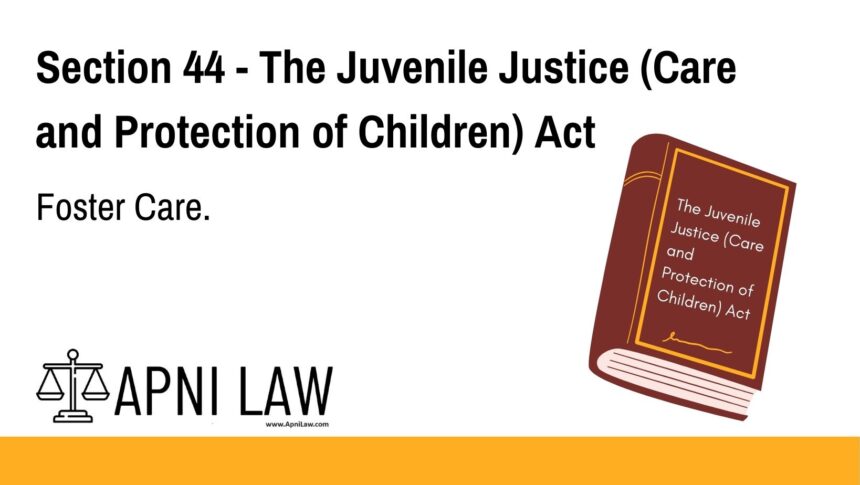Code: Section 44 — Foster Care
(1) The children in need of care and protection may be placed in foster care, including group foster care, through orders of the Committee, after following the prescribed procedure. They may be placed in a family that does not include the child’s biological or adoptive parents or in an unrelated family recognized as suitable by the State Government, for a short or extended period.
(2) The selection of a foster family must be based on the family’s ability, intent, capacity, and experience in caring for children.
(3) Siblings should be kept together in foster families, unless it is determined that separation is in their best interest.
(4) The State Government shall provide monthly funding for foster care through the District Child Protection Unit, after following the prescribed procedures. Regular inspections must be conducted to ensure the child’s well-being.
(5) If children are in foster care due to parental incapacity or unfitness, parents may visit their child regularly unless such visits are considered not in the child’s best interest. Once the Committee finds the parents fit again, the child may return home.
(6) The foster family is responsible for providing education, health, and nutrition to the child and ensuring the child’s overall well-being as per the prescribed manner.
(7) The State Government may make rules to define the procedure, criteria, and manner of providing foster care services.
(8) The Committee shall inspect foster families monthly to ensure the child’s well-being. If a foster family fails to care for the child, the child must be shifted to another suitable family.
(9) No child declared adoptable by the Committee shall be placed in long-term foster care.
Explanation of Section 44
Section 44 of the Juvenile Justice Act lays the foundation for the foster care system in India. It authorizes the Committee to place children who need care and protection into foster families, including group settings, for short or extended durations.
These families must be selected based on capability and must not be related biologically or through adoption. The law ensures that children are placed in safe, caring environments. It also emphasizes sibling unity, regular inspections, financial support, and eventual family reunification where possible.
Illustration
Example 1: Foster Placement Due to Parental Illness
A child is placed in foster care because their parents are temporarily unfit due to illness. A vetted foster family provides care for six months. Once the parents recover and are deemed fit by the Committee, the child is reunited with them.
Example 2: Group Foster Care for Siblings
Three siblings are found living on the streets. The Committee arranges for them to stay together in group foster care with a qualified family. Keeping the siblings together helps preserve emotional bonds and stability.
Common Questions and Answers on Section 44
1. What is the objective of foster care under Section 44?
Foster care provides temporary family-based support to children who cannot live with their parents due to safety, health, or social concerns.
2. Who is eligible to become a foster family?
Foster families must be assessed and recognized by the State Government. The selection is based on ability, experience, and commitment to child care.
3. Can biological parents reunite with children in foster care?
Yes. If the Committee finds that the parents have regained the ability to care for the child, reunification is possible.
4. Are foster families paid?
Yes. The State Government provides monthly financial support through the District Child Protection Unit to help foster families meet the child’s needs.
5. What if a foster family fails to care for the child?
If inspections reveal negligence or incapacity, the child will be shifted to a different foster family.
Conclusion
Section 44 ensures that children without parental care receive protection in a family environment. The law promotes accountability through inspections, funding, and regular monitoring. It prioritizes the child’s well-being and strives for eventual family reintegration wherever possible.
For more legal content and structured case explanations, visit ApniLaw.








